Garbage polluting Maussakele Reservoir
BY Niranjala Ariyawansha
Environmental organizations claim that the Maussakele Reservoir, which supplies water to main hydropower stations in the upcountry, is polluted by the dumping of solid waste, which does not perish. This, they say, is severely affecting the surrounding environment and the fish in the reservoir.
According to the Ceylon Electricity Board (CEB), the Maussakele Reservoir supplies water to the New Laxapana and Canyon Hydro Power Stations.
Environmentalists emphasize that water from the Maussakele Reservoir, is being supplied through the Maskeliya Oya and daily, a large amount of garbage is being thrown into this reservoir. They said that on rainy days, garbage from the Maskeliya city is also dumped into the reservoir.
Since there is no rain these days, the water level in the reservoir has dropped and the garbage that has been deposited on the bottom of the reservoir can be clearly seen, according to environmentalists.
Responding to a Ceylon Today, inquiry, Deputy General Manager of the Laxapana Power Plant Complex, Anura Herath said that, this has become a huge problem.
“Actually it is the people who should basically be aware of this situation. As a result of this dumping of waste, drinking water gets polluted. Garbage from residents in the vicinity of the reservoir, as well as from the Maskeliya city is disposed of into the Maussakele Reservoir. During the Sri Pada season, people also travel on this road. Then, a large number of non-perishable items, such as empty water bottles and other waste are collected. As the CEB, even though we remove this waste, we do not have adequate staff. People should know, not to cause harm to public property in this manner,” Herath said.
He added that under these circumstances, in collaboration with the Divisional Secretary, a programme to raise awareness among the public, is required.
Under the Laxapana Power Stations Complex, which belongs to the National Power Grid, Laxapana, New Laxapana, Wimalasurendra, Canyon and Polpitiya hydropower plants are situated around and in the vicinity of the Maussakele Reservoir.
Source – 01/04/2017, Ceylon Today , See more at – http://www.ceylontoday.lk/print20170101CT20170331.php?id=18296
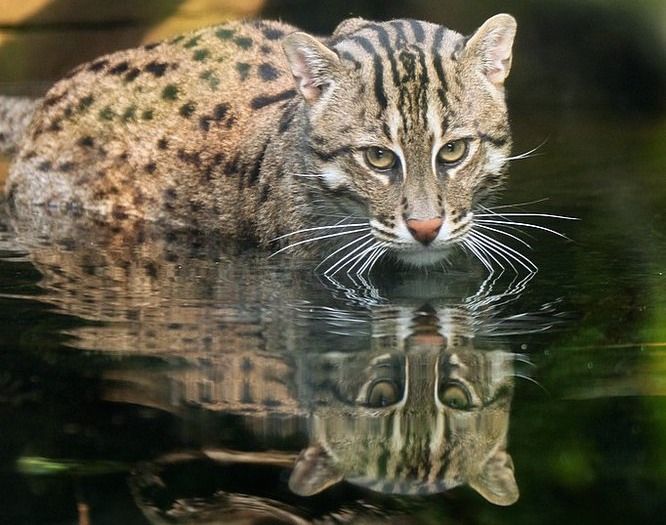
Wildlife men responsible for wildcat’s death?
By Risidra Mendis
Environmentalists have criticized Department of Wildlife Conservation (DWLC) officers after they failed to save the life of a fishing cat after it was captured by villagers in Divulapitiya, Gampaha.
An official at the Gampaha DWLC office told Ceylon Today that villagers had captured the adult male fishing cat with a noose on 25 March 2017.
“When the animal got restless and began struggling, the villagers called the DWLC for help. But by the time we got to Divulapitiya, the cat was in a bad condition.Wildlife officers tried to remove the noose from the animal’s neck and release it. But the villagers protested and told us not to release the animal in this area. When we were trying to catch the cat and put it in a cage to be taken away, the noose tightened and the animal died,” the DWLC officer said.
He added that one of the wildlife officers was also bitten by the fishing cat while trying to catch it. The animal’s head was sent to the Medical Research Institute to check for rabies.
Asked why they took orders from the villagers a DWLC officer said they didn’t want to create an unpleasant situation since the media was also present and decided to capture the animal and take it away.
“We cannot find out who caught the fishing cat because the villagers are not giving us any information. However we have told them that catching a fishing cat is against the Fauna and Flora Protection Ordinance (FFPO),” the DWLC officer explained.
“The fishing cat is strictly protected under Section 30 sub section 2 of the FFPO and it is an offence to kill, injure or take an animal into captivity,” environment lawyer Jagath Gunewardena said.
Commenting on the inexperienced DWLC officers, Zoologist Dilan Peiris said it is very clear in the video that the DWLC officers were responsible for the death of the fishing cat. “They should have first cleared the crowds that were watching and shouting and traumatizing the animal. They should know how to catch a wild animal in an emergency situation without causing too much stress to the animal. If they had the proper training to capture a wild animal this fishing cat would be alive today. The Wildlife Training Centre in Giritale does not provide the required training for these DWLC officers,” Peiris said.
He added that a veterinary surgeon should have been present to capture this animal. But DWLC officers insist that they don’t have enough vets to be sent in emergency situations. Why is it that vets don’t like to join the Wildlife Department? These are questions that need to be addressed by Wildlife and Sustainable Development Minister Gamini Jayawickrama Perera, because it is the responsibility of the Department of Wildlife Conservation (DWLC) to help and protect all animals in the country,” Peiris explained.
source – 02/04/2017, Ceylon Today, See more at – http://www.ceylontoday.lk/print20170101CT20170331.php?id=18415

Move to protect forests adjoining Wilpattu triggers diverse reactions
Locals protest moves to declare more than 40,000 hectares as conserved forest area.
Environmental groups have welcomed the declaration made on March 24 under the Forest Conservation Ordinance to protect more than 40,000 hectares, but locals are demanding that the presidential extraordinary gazette notice be revoked.
Secretary to the President, P. B. Abeykoon on Friday met with some of the stakeholders including the Forest Conservator General, officials from the Wildlife and Mahaweli Development Ministry, the District Secretaries of Mannar and Vauniya as well as representatives of the Muslim community including Minister Rishad Bathiudeen, former Municipal Council member Asath Sally, Colombo District lawmaker Mujibur Rahuman and President of the Muslim Council N.M. Ameen. Members of the Civil Societies Coalition for Internally Displaced Persons, which is opposed to the decision, also joined the discussion.
Abeykoon said their concerns would be brought to the notice of President Maithripala Sirisena who issued the declaration.
Under the notice, 40,0030.525 hectares of forest area belonging to Mavillu, Weppal, Karadikkuli/Marichchakatti, Wilaththikulam and Periyamurippu were declared as the Mavillu Conservation Forest from March 21, 2017.
Muslim Council president N. M. Ameen told the Sunday Times that they requested that the four notifications be revoked and that the lands from Weppal, Marichchikatti and Wilaththikulam be released to the people. He said that before new forest reserves are demarcated, the Government should have discussions with the people.
Mujibur Rahuman said he told the president’s secretary that the Mavillu conservation area had been demarcated without discussing the matter with ministers and the community.
He explained that many of the Muslims living in the area had been displaced due to terrorist activities. He said that privately-owned land had also been included under the gazette notice.
“We requested that the implementation of the gazette notice be put on hold while the boundaries of the Wilpattu National Park are determined,” he said.
Mohamad Ali Khan, a resident of Marichchakatti, who was among a group of protestors, said many families have lived there for over two decades and they should be allowed to continue to do so.

Minister Rishad Bathiudeen in a statement said that the declaration was affecting the internally displaced people. He said the gazette notice must be revoked as it is impacting the resettlement process.
He said he will present a Cabinet paper seeking the revocation of the notice.
Government Agent of Mannar, M Y S D Deshapriya said he was not aware of the notice and declined comment.
Meanwhile, the president’s media secretary, Dharmasiri Ekanayake, said the declaration will stand as it does not affect villages.
He said that the declaration was issued as a matter of urgency because environmental groups and forest and wildlife officials were pushing for it.
“They expressed concerns that there will be further encroachment of forest areas,” he said.
Director of Environment Conservation Trust, Sajeewa Chamikara, said that they called for the protection of the areas adjacent to the Wilpattu National Park.

Source – 02 /04/2017, The Sunday Times, See more at – http://www.sundaytimes.lk/170402/news/move-to-protect-forests-adjoining-wilpattu-triggers-diverse-reactions-235019.html
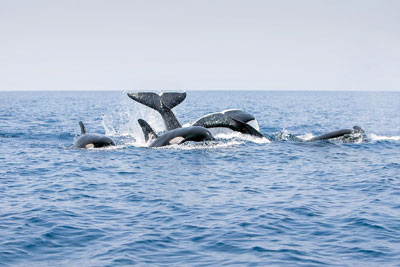
Super pods of sperm whales put on marine spectacle
The eight-strong orca pod get ready to charge towards the sperm whales. Pix courtessy Andrew Sutton.
While observing a super pod of nearly 100 sperm whales, marine mammal expert Ranil Nanayakkara witnessed a rare occasion when killer whales attacked the marine giants in the seas off Kalpitiya. It was an epic battle.
Sri Lanka is famous for wildlife spectacles such as this along with the largest gathering of Asian elephants, huge pods of blue whales and rare sightings of leopards.
One spectacle in the making is super pods of sperm whales (physeter microcephalus). The sperm while is the largest ‘toothed whale’ which can dive to depths of 3,200 feet in search of its favourite food – the giant squid. Female sperm whales and their calves live in pods of 15-20 members, while males tend to roam alone in cooler waters closer to polar regions. A super pod of whales is formed when such smaller pods gather for feeding, socialising or mating. March to April seems to be the time such super pods form and in 2012 the largest such gathering consisting of over 100 individuals was recorded.
Marine biologist Ranil Nanayakkara who has studied the sperm whale super pods from 2010, left Kalpitiya shores on March 23 to scan the ocean specially for sperm whales. It turned out to be their lucky day when they witnessed the sperm whale super pod about 15 nautical miles from Kalpitiya at 9.15 am after travelling for about one hour. “There were over 150 sperm whales on the ocean of around one kilometre. The super pod we saw consisted of 50 to 60 individuals,’’ Nanayakkara said.
Together with Ranil, British author Philip Hoare and photographer Andrew Sutton were on the boat and it was a show of a life time. The larger sperm whale males had joined the super pod and they witnessed love making on a massive scale. The team witnessed foreplay — rubbing against each other, tail slapping, spy hopping, rolling over. Even researchers could see the animals’ aroused genitals and as they watched, a pair swam belly to belly under the boat.
The sperm whale is also famous for making sounds. It makes the loudest sounds of any animal and also emits morse-like “codas” used to communicate long distances. The sea is full of sound as well and Nanayakkara was listening to these codas using special ear phones.
The ocean was like an opera, said Nanayakkara.
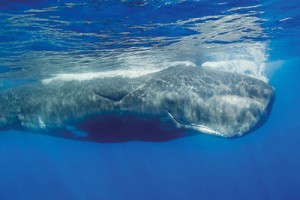
They observed a large male deviate from the super pod and swim rapidly northward. “When a sperm whale swims fast, its large head stays out of the water – so we could clearly say it was in a great hurry. Then several other large males started following the first one. Seeing several large male sperm whales moving northward we thought it could be an aggression related to mating, so we followed them,” Nanayakkara explained.
After travelling two or three kilometres, the team found the large males with a pod of about 10 females with younger whales. The males packed their bodies tightly and it was like several logs stacked tightly. The men in the boat also saw something else. One person in the boat alerted the others to a dolphin but to their surprise it was the unmistakable dorsal fin of an orca. The sperm whales had rushed to protect the pod that came under attack by the orcas.
The black and white orca (orcinus orca), is a mid-sized toothed whale. it is the largest member of the dolphin family and became a popular after being featured in the movie ‘Free Willy’. But the orca is not an innocent animal as it is an agile predator in the ocean also known as the ‘killer whale’.
“It was a pod of about eight orcas attacking a weaker maternity pod. The large males would have heard the distress call and had rushed to protect them. The males packed their bodies side by side tightly guarding the weaker whales from the predatory orcas,” Nanayakkara said. The water around the smaller pod was cloudy with orangish whale poop – a defense mechanism used by the distressed whales to conceal themselves from the predators.
Killer whale attacks on other whales have been reported on a handful of occasions previously. Working as a team, they usually challenge the weaker female or a calf to hunt it down. According to Nanayakkara, the orcas found in our waters is transient and they are born hunters.
“We had also observed an amazing communal defense mechanism used by the sperm whales where the males encircle the weaker females and young putting their bodies in front of the attacking killer whales,” Nanayakkara said. This is a known as the “marguerite formation”, named after the shape of the flower by that name. In this formation, the heavy and powerful tail of an adult whale is pointed outward, readying to deliver lethal blows to any incoming attacker.
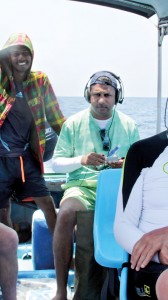
The researchers also experienced a somewhat scary experience. Since the marguerite formation was not effective, the whales started using the boat as a cover to avoid the orcas. They moved to the other side of the boat when the orcas charged and a collision could have been dangerous.
This ‘battle of the titans’ dragged on for more than an hour. The sperm whales finally made the orcas give up. Nanayakkara said there were about 20 killer whales at that time and it could also be the largest orca pod seen in Sri Lankan waters.
Nanayakkara said it was one of the amazing moments he had witnessed in his whole life.
| Know the sperm whaleThe head of the whale contains a liquid wax called spermaceti, from which the whale derives its name. Spermaceti was used in lubricants, oil lamps, and candles. Scientists have yet to understand its function, but believe it may help the animal regulate its buoyancy. Some also believe that the spermaceti has bio-acoustical amplification properties, enabling the whale to produce the loudest sounds of any animal.Mature males average 16 metres (52 ft) in length but some may reach 20.5 metres (67 ft), with the head representing up to one-third of the animal’s length. Capable of plunging to 2,250 metres (7,382 ft), it is the second deepest diving mammal, following only the Cuvier’s beaked whale. The sperm whale’s clicking vocalisation, a form of echolocation and communication, may be as loud as 230 decibels under water. The sperm whale has the largest brain of any animal on Earth, more than five times heavier than a human’s. Sperm whales can live for more than 60 years according to sources on the Web.Ambergris, a waste product from its digestive system, is still used as a fixative in perfumes. |
Source – 02/04/2017,The Sunday Times, See more at – http://www.sundaytimes.lk/170402/news/super-pods-of-sperm-whales-put-on-marine-spectacle-234975.html
CEA permits mini-hydro projects sans EIA: RPSL
An alliance of environmentalists are protesting against the Central Environmental Authority’s (CEA) continued issuance of permits to mini-hydro plants across waterfalls, streams and rivers in the wet zone, despite, what they allege, are several ecological and social issues. The CEA has “ignored all pleas by villagers and environmental groups, and are still issuing new permits, as seen by their recent approval to construct another private mini-hydro plant across Athwelthota waterfall,” states the Rainforest Protectors of Sri Lanka (RPSL).
These projects are carried out by a handful of private companies with the sole aim of generating maximum profit. “The current process does not involve any Environmental Impact Assessment (EIA) by an independent organisation, with public comments,” the association says. “Instead, the developers themselves submit an Initial Environment Examination (IEE) report which is biased and full of false information.”
Such reports are habitually approved by the CEA without field investigations, during or after construction. Approximately 1,000 km of streams and rivers have already dried out, resulting in many villagers and farmers suffering due to lack of water. “Many rare and endemic freshwater fish are heading towards extinction, and the country is losing valuable income due to impact on eco-tourism,” the RPSL warns. “Any development process should not be an ignorant one, but a conscious one with a focus on sustainability. Therefore, the national energy policy of Sri Lanka should be centred on ecologically sustainable energy, which would protect the water rights of the people and continuation of aquatic ecosystems.”
The RPLS reveals that, “Forest land adjoining the Koskulana River, forming the northern boundary of the Sinharaja World Heritage Rainforest, has been cleared of all vegetation, for the construction of a mini-hydro project, in clear violation of the State Land Ordinance.”
“At Anda Dola in the Galle District, a weir and 2.5 km section of concrete headrace channel are both constructed within the Dellawa Forest Reserve. Construction activities within a protected forest reserve are a violation of the Forest Ordinance of 1907, and punishable by law. The IEE report produced by the developer for the Anda Dola mini-hydro has failed to include many endemic species that inhabit the stream and surrounding forest.”
A report prepared by the Wildlife Conservation Society of Galle and submitted to the CEA, points out that, “Environmental and biodiversity information, including species of fauna, in many pages of the developer’s IEE are incorrect and misses many species.
“Findings of widespread violations indicate systemic failure of the entire process in place for the assessment of mini-hydro projects,” the RPLS states. “It is, in effect, a breach of trust in the very institutions that gate-keep approvals, and fully justifies the public’s scepticism in them.”
Source – 02/04/2017, The Sunday Times, See more at – http://www.sundaytimes.lk/170402/news/cea-permits-mini-hydro-projects-sans-eia-rpsl-235068.html
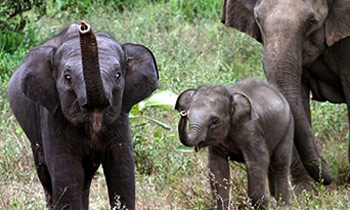
SL animal activists stop elephant flying to New Zealand
A Sri Lankan baby elephant gifted to New Zealand has been prevented from leaving the South Asian island after animal activists said it was cruel to separate her from her family.
Six-year-old Nandi was bequeathed to former New Zealand Prime Minister John Key by President Maithripala Sirisena at a meeting in Colombo in February 2016 to mark ‘excellent bilateral relations’ between the two countries. New Zealand vets had visited Sri Lanka last year to prepare Nandi for the journey to Auckland Zoo.
But animal rights activists have since intervened, arguing against moving the elephant to a foreign country where she will likely find it difficult to be separated from her family and adapt to the new climate.
The group of 18 secured a temporary victory Friday when a Sri Lankan court was assured by the state that Nandi would not be flown out of the country pending a final decision on the case next month.
‘Sri Lankan elephants have very strong family ties and to take away a child is a sin,’ Omalpe Sobitha, a Buddhist monk and one of the activists, told AFP. He added that the animal may not be able to cope with the cold weather in Auckland, where mean annual temperatures of around 15 degrees Celsius (59 Fahrenheit) would come as a shock to a calf used to the tropical 27 degree average in Sri Lanka.
‘We have an assurance from the court yesterday (Friday) that Nandi will not be taken out of the country until the case is concluded’, he said. Born and raised in a 93-strong herd in a coconut grove at an orphanage in central Sri Lanka, Nandi is the second baby elephant to be presented to New Zealand in a year after a female baby ‘Anjalee’ was sent to Auckland Zoo in 2015.
Key told Sirisena at their meeting last February that Anjalee had gained 700 kilos (1,540 pounds) in one year and that it was ‘loving its life in New Zealand and I am sure its friend (Nandi) will have such a good time as well in New Zealand’. Sri Lanka has a long history of giving elephants as presents — China has been gifted three over the years, and two each for Japan, South Korea, the Czech Republic and the United States.(AFP)
Source – 02/04/2017, Dailymirror, See more at: http://www.dailymirror.lk/article/SL-animal-activists-stop-elephant-flying-to-New-Zealand-126604.html#sthash.AepWVVpG.dpuf







